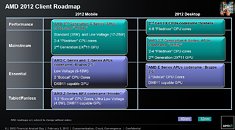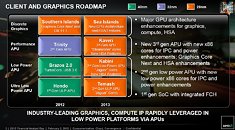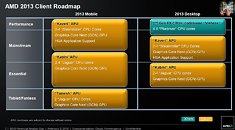Thursday, February 2nd 2012

AMD Outlines Its 2012-2013 Client Roadmap, Big Focus is on APUs
Today at its annual Financial Analyst Day, AMD has presented an updated roadmap detailing the hardware it plans to bring to the table during 2012 and 2013. For this year, the Sunnyvale-based company is preparing a processor quarter which includes the Trinity, Brazos 2.0 and Hondo APUs (accelerated processing units) and the Vishera CPU.
Set to be the main weapon in AMD's x86 arsenal, the Trinity APU (aka the 2nd gen A Series) is made on 32 nm process technology, and features DirectX 11 graphics, two/four Piledriver cores (Piledrive is said to deliver 25% better performance than the Stars cores found in Llano APUs), and a TDP that can go as low as 17 W on mobile parts. Trinity is expected to debut in Q2 and already has close to 100 design wins (more than Llano had before its release).The Brazos 2.0 (C and E Series) and Hondo (Z Series) APUs are 40 nm parts and feature up to two Bobcat cores, DirectX 11 graphics, and a TDP going from 4.5 W to 18 W. These are designed for low-power/low-cost mobile and desktop devices.
On the CPU front 2012 will see to the arrival of the 32 nm Vishera parts (2nd gen FX Series) which will feature 4, 6 or 8 Piledriver cores. Interestingly-enough, Vishera is listed as the sole CPU for 2013 desktops too so it seems AMD won't be doing much in this segment, apart from maybe releasing higher-clocked models.
For 2013 AMD is readying a LOT of 28 nm chips, including the Sea Islands GPUs - said to have a 'new architecture' and HSA (Heterogeneous Systems Architecture) features, and the Kaveri, Kabini and Temash APUs.
Kaveri is Trinity's successor and it will feature a DirectX 11.1-supporting (GCN-based) GPU, 2 to 4 Steamroller x86 cores, and HSA application support. Kaveri will cover the mainstream mobile and desktop segment so Kabini and Temash will focus on lower-cost/lower-power hardware.
Both Kabini and Tamesh will have GCN graphics and will make use of Jaguar x86 cores. Kabini will have up to four x86 cores while Tamesh will feature two. No ARM in sight here, maybe we'll have to wait a bit more...
Source:
PC Perspective
Set to be the main weapon in AMD's x86 arsenal, the Trinity APU (aka the 2nd gen A Series) is made on 32 nm process technology, and features DirectX 11 graphics, two/four Piledriver cores (Piledrive is said to deliver 25% better performance than the Stars cores found in Llano APUs), and a TDP that can go as low as 17 W on mobile parts. Trinity is expected to debut in Q2 and already has close to 100 design wins (more than Llano had before its release).The Brazos 2.0 (C and E Series) and Hondo (Z Series) APUs are 40 nm parts and feature up to two Bobcat cores, DirectX 11 graphics, and a TDP going from 4.5 W to 18 W. These are designed for low-power/low-cost mobile and desktop devices.
On the CPU front 2012 will see to the arrival of the 32 nm Vishera parts (2nd gen FX Series) which will feature 4, 6 or 8 Piledriver cores. Interestingly-enough, Vishera is listed as the sole CPU for 2013 desktops too so it seems AMD won't be doing much in this segment, apart from maybe releasing higher-clocked models.
For 2013 AMD is readying a LOT of 28 nm chips, including the Sea Islands GPUs - said to have a 'new architecture' and HSA (Heterogeneous Systems Architecture) features, and the Kaveri, Kabini and Temash APUs.
Kaveri is Trinity's successor and it will feature a DirectX 11.1-supporting (GCN-based) GPU, 2 to 4 Steamroller x86 cores, and HSA application support. Kaveri will cover the mainstream mobile and desktop segment so Kabini and Temash will focus on lower-cost/lower-power hardware.
Both Kabini and Tamesh will have GCN graphics and will make use of Jaguar x86 cores. Kabini will have up to four x86 cores while Tamesh will feature two. No ARM in sight here, maybe we'll have to wait a bit more...




29 Comments on AMD Outlines Its 2012-2013 Client Roadmap, Big Focus is on APUs
and what about seaislands 2013 HSA everything :), dont know what it stands for but im thinking its the start of some advanced cpu gpu work shareing etc , anyone know more?
Isnt it strange to suddenly go for gfx amount nm?
They're right though to focus on apu, thats where they can make a bundle and it's a really big potential market. Profit margins on ultrabooks should be a bit more allowing as well. As Apple have set the standard there money wise.
Though just because Intel is on 22nm while everyone else is on 32/28nm doesn't mean that the Intel process is better then everyone else.
Really !!why would they need to for 4 cores+ gfx at medium to low performance price point, and if they dont need to and 40nm is cheaper why the hell would they, plus 40nm prod line has something tobe getting on with
Under desktop performance 2012 chart and desktop performance 2013 chart they both mention Piledriver 4-8 core 2nd Gen "Vishera".
So is Piledriver coming out in 2012 or 2013. Someone clear this up!
The answer will be released in q1 of 2014
Abu Dahbi, Seoul, Delhi, and Vishera will span 2012-2013 you can take it as the death of the high-end/server for AMD
G2012/C2012/FM2 not being the three new chipsets equals death and Cray is going to be pissed
Aries Interconnect delayed till 2014+
loser !
Besides TPU didn't include the slide that talked about the 18mm thick ultra thin platform that AMD talked about that would be less then $900. 17w Trinity and 18mm thin notebooks, Brazo really isn't needed then. Push Brazo down in to tablets as that is the real purpose of that platform anyway.
Hey, Super XP, I like your optimism
instead of the usual where bottom end is ignored (and always terribad) with progress only being made in the expensive high end, now we suddenly get low end devices with so much more GPU power than we're used to.
i prefer the minimum spec to get the most improvements over the high spec, because it means the average machine is now more powerful, instead of just extremely expensive ones.
for people buying or using low end hardware, its awesomesauce.
Piledriver doesn't have a 25% IPC improvement over Stars it has a 25% IPS improvement
IPC for Trinity has stayed the same and Clock Rate has went up 25%
The only Piledriver to have an IPC increase is Vishera(and other parts that are on the server) and it isn't Komodo which would have been on FM2
I don't think Mr. Read is dumb enough to ditch a processor segment that has some of the highest ASPs. It is possible that the server/workstation roadmap hasn't changed much. What this roadmap tells is that the 'Performance Desktop' segment will probably die with Vishera.
I don't know what you are reacting on D:
I'm just pointing out only G2012/C2012/FM2 chipsets compete with LGA2011/LGA1155
G34/C32/AM3+ only competes with LGA 1567/LGA 1366/LGA 1156 EOL'ed chipsets
Improvements in Power Consumption, PCIe Latency, and HDD/SSD performance down the drain with no Terramar, Sepang, and Komodo....AMD is dead in servers and workstations